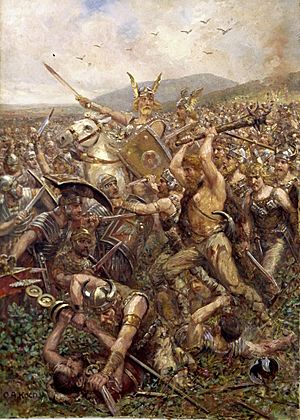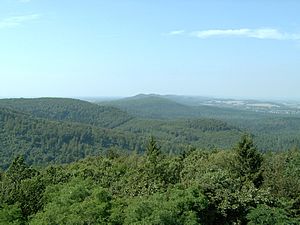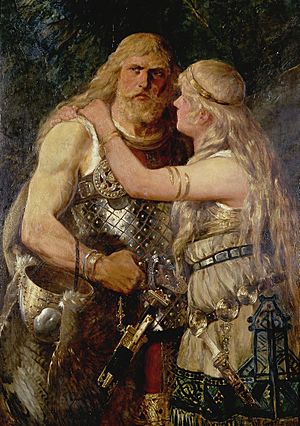Arminius facts for kids
Quick facts for kids Arminius |
|||||
|---|---|---|---|---|---|
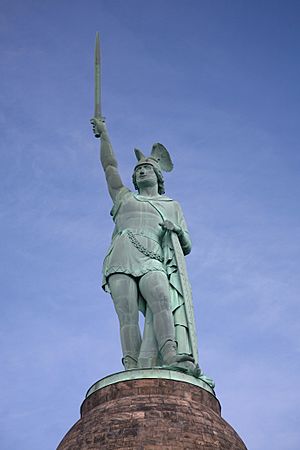
Statue of Arminius at the Hermannsdenkmal memorial
|
|||||
| Prince and Chieftain of the Cherusci tribe | |||||
| Predecessor | Segimer | ||||
| Successor | Italicus | ||||
| Born | 18/17 BC Germania |
||||
| Died | 21 AD (aged 37–38) Germania |
||||
| Spouse | Thusnelda | ||||
| Issue | Thumelicus | ||||
|
|||||
| Father | Segimer | ||||
| Religion | Germanic | ||||
Arminius (born 18/17 BC – died 21 AD) was a brave leader of the Germanic Cherusci tribe. He is famous for leading an alliance of Germanic tribes to a huge victory against the Roman Empire in 9 AD. This battle, known as the Battle of the Teutoburg Forest, saw three powerful Roman legions completely destroyed.
Arminius' victory at Teutoburg Forest was a major turning point. It stopped the Romans from taking over and changing the Germanic tribes east of the Rhine river. Many historians believe it was one of Rome's biggest defeats and a very important battle in human history.
Arminius was born a prince of the Cherusci tribe. He learned Latin and even served in the Roman military. This service earned him Roman citizenship and a special rank. After fighting well in a big revolt, he was sent back to Germania. His job was to help the Roman governor, Publius Quinctilius Varus, finish conquering the Germanic tribes. But secretly, Arminius was planning a revolt against Roman rule. This plan led to the ambush and destruction of the Roman legions in the Teutoburg Forest.
After his great victory, Arminius fought against Roman armies led by General Germanicus. He also fought against a rival king, Maroboduus. Sadly, other Germanic nobles, who feared Arminius' growing power, killed him in 21 AD. For many years, people remembered him in Germanic legends. The Roman historian Tacitus even called Arminius the liberator of the Germanic tribes. He praised Arminius for standing up to the mighty Roman Empire.
In the 1800s, when Germany was uniting, Arminius became a symbol of German unity and freedom. However, after World War II, his importance in Germany lessened because he was linked to aggressive nationalism.
Contents
Who Was Arminius?
Arminius was a prince of the Cherusci tribe. He was born in Germania around 18 or 17 BC. His father, Segimerus, was also a Cheruscan chief and was friendly with Rome.
Arminius learned to speak Latin and joined the Roman military. His younger brother, Flavus, also served. Arminius fought for Rome between 1 and 6 AD. During this time, he received a military education. He also gained Roman citizenship and the status of an equite (a Roman knight). These experiences taught him a lot about Roman politics and how their army fought. This knowledge helped him greatly in his later battles against Rome.
What Was His Real Name?
The exact origin of the Latin name Arminius is not fully known. Some scholars also called him Armenus. Because of how Romans named people back then, Arminius was likely a name given to him when he became a Roman citizen. It was probably not his original Germanic name.
In the 1500s, Martin Luther translated Arminius into the German name Hermann. Hermann means "Man of War." This name became very popular for Arminius in Germany. People often called him "Hermann the Cheruscan" or "Hermann the Cheruscan Prince."
The Battle of the Teutoburg Forest
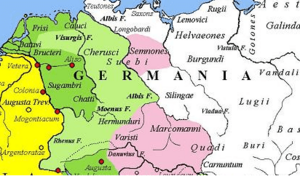
Around 4 AD, Arminius became a leader in a Cheruscan group that helped the Roman army. He probably fought in wars on the Balkan peninsula. In 7 or 8 AD, he returned to northern Germania. The Roman Empire had taken control of lands east of the Rhine river. Now, they wanted to expand even further east, towards the Weser and Elbe rivers. Publius Quinctilius Varus, a Roman governor, was in charge of this expansion.
Arminius secretly began to plan. He wanted to unite different Germanic tribes to stop Rome from taking their lands. This was hard because the tribes were very independent. Many were even enemies with each other.
Between 6 and 9 AD, Rome had to move many of its legions from Germania. Eight out of eleven legions went to crush a rebellion in the Balkans. This left Varus with only three legions in Germania. That was still about 18,000 soldiers. Arminius saw this as the perfect chance to defeat Varus.
In the autumn of 9 AD, Arminius, who was about 25 years old, tricked Varus. He told Varus there was a rebellion in northern Germany. He convinced Varus to march his three legions (the 17th, 18th, and 19th legions, plus cavalry and other troops) to stop this fake rebellion. Varus and his legions marched right into a trap Arminius had set. The trap was near a place called Kalkriese.
Arminius' tribe, the Cherusci, and their allies (the Marsi, Chatti, Bructeri, Chauci, and Sicambri) ambushed the Roman army. The Romans were marching along a narrow road through a thick forest. Arminius' forces attacked and completely destroyed Varus' entire army, which had over 20,000 men. When Varus realized defeat was certain, he took his own life.
This battle was one of the worst defeats Rome ever suffered. Arminius' success in destroying three legions and pushing the Romans out of Germany was a huge moment for Germanic power.
After the Battle
After the battle, the Germans quickly removed all signs of Roman presence east of the Rhine. Roman settlements were abandoned. A small Roman army at Aliso fought bravely. They caused many losses for the Germans before retreating. This allowed other Roman forces to organize a defense at the Rhine. This stopped Arminius from crossing the Rhine and invading Gaul.
Between 14 and 16 AD, the Roman general Germanicus led attacks into Germany to get revenge. He fought Arminius in several battles. In 15 AD, Roman troops got back one of the three legionary eagles (important symbols) lost at Teutoburg Forest. In 16 AD, they got a second eagle back. The Roman emperor Tiberius decided that the border with Germania should stay at the Rhine river. He did not want more campaigns. The third Roman eagle was found later, in 41 AD.
Arminius also faced problems from his own family. His father-in-law was pro-Roman. His brother, Flavus, stayed loyal to Rome and even fought against Arminius. After the Roman threat lessened, Arminius fought a war against Marbod, the king of the Marcomanni. This war ended in a stalemate.
In 21 AD, Arminius was murdered by people within his own tribe. They felt he was becoming too powerful.
Arminius' Marriage
Arminius married a Germanic princess named Thusnelda. Her father, Segestes, was a Cheruscan prince who supported Rome. Around 14 AD, after the Battle of the Teutoburg Forest, Arminius took Thusnelda. This was likely because her father was against their relationship.
In May 15 AD, the Roman general Germanicus captured Thusnelda. She was pregnant at the time and living with her father, who had taken her back. Arminius was very sad about losing Thusnelda and did not marry again. Tacitus wrote that Arminius was "driven to frenzy" by her capture. Thusnelda gave birth to a son named Thumelicus. He grew up as a Roman captive.
Arminius' Lasting Impact
Arminius' victory against the Roman legions had a huge impact on the history of both the ancient Germanic peoples and the Roman Empire. The Romans never again tried to conquer and permanently hold the lands beyond the Rhine. Many modern historians call Arminius' victory one of the most important battles in history. Some even call it "Rome's greatest defeat."
Why Rome Stopped Expanding
Rome's decision to stop expanding into Germania was not just because of Arminius. Politics played a role too. Emperors often didn't trust their generals with large armies, fearing they might become rivals. Also, Germania was a less developed land with few towns and not much extra food. Conquering it would have been too expensive and required too many soldiers.
Scholars today also point out that the Rhine river was a more practical border for the Roman Empire. Armies on the Rhine could easily get supplies from the Mediterranean Sea. Armies further east, like on the Elbe river, would have needed long and difficult supply routes. The Rhine area already had towns and was better set up to support large armies.
Instead of direct rule, Rome chose to influence Germanic tribes by appointing friendly kings. For example, Arminius' nephew, Italicus, became king of the Cherusci. When indirect methods didn't work, Roman emperors sometimes led harsh attacks deep into Germania.
Arminius in Legends
In the early 1800s, some people thought that the story of Arminius might have lived on in old Norse legends. They believed he could be the dragon slayer Sigurd from the Völsunga saga. One Icelandic story says Sigurd killed a dragon in a place that might have been near where Varus' legions began their march to the Teutoburg Forest.
Arminius and German Identity
During the unification of Germany in the 1800s, Arminius became a powerful symbol of German unity and freedom. Martin Luther had already linked Arminius to the name Hermann. So, "Hermann the Cheruscan Prince" became a symbol of rising German nationalism. This was especially true after the Napoleonic Wars.
In 1838, work began on a huge statue of Arminius, called the Hermannsdenkmal. It was built on a hill near Detmold in the Teutoburg Forest. The statue was finally finished in the early years of the Second German Empire, after Germany won the Franco-Prussian War (1870–1871). This monument has been a popular tourist spot ever since. A similar statue, the Hermann Heights Monument, was built in New Ulm, Minnesota, in the United States in 1897. This statue was put up by a group of German Americans. The town of Hermann, Missouri, also got its name from Arminius.
After the rise of Nazi Germany and its defeat in World War II, Arminius became less known in West Germany. Many schools avoided teaching his story in detail because of its past link to aggressive nationalism. However, in East Germany, Arminius was sometimes seen as a revolutionary hero. He was viewed as leading German tribes against the Roman "slaveholder society." In the context of the Cold War, Arminius was even seen as a symbol of socialism, with Rome representing the capitalist United States.
Today, German nationalism is much less aggressive. It mostly shows up at sporting events like the soccer World Cup. The German football club DSC Arminia Bielefeld is named after Arminius. The 2,000-year anniversary of the battle was celebrated in New Ulm, Minnesota, with mock battles and lectures.
See also
 In Spanish: Arminio para niños
In Spanish: Arminio para niños
- Ariovistus
- Bato the Breucian
- Bato the Daesitiate
- Boudica
- Divico
- Gaius Julius Civilis
- Teutobod
- Vercingetorix


